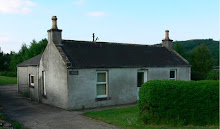 The current Radar magazine has a fascinating article about Genesis P-Orridge and Lady Jaye, who were so in love they decided to become one person, and then one of them died. Their stated goal of Pandrogeny was both romantic and conceptual. They were not adhering to pre-conceived notions of beauty (or even gender), nor were they attempting to become twins. They were challenging the nucleic acids that contain the building blocks of all life. "We replicate as much to perpetuate DNA as to perpetuate our species" said P-Orridge, who views DNA as an evolutionary parasite, with the human body as the host environment. Matching haircuts and clothes were followed by breast implants for both, nose jobs, eye surgery, a chin implant, collagen lip enhancements, etc. - all in order to better become one another.
The current Radar magazine has a fascinating article about Genesis P-Orridge and Lady Jaye, who were so in love they decided to become one person, and then one of them died. Their stated goal of Pandrogeny was both romantic and conceptual. They were not adhering to pre-conceived notions of beauty (or even gender), nor were they attempting to become twins. They were challenging the nucleic acids that contain the building blocks of all life. "We replicate as much to perpetuate DNA as to perpetuate our species" said P-Orridge, who views DNA as an evolutionary parasite, with the human body as the host environment. Matching haircuts and clothes were followed by breast implants for both, nose jobs, eye surgery, a chin implant, collagen lip enhancements, etc. - all in order to better become one another. I met P-Orridge and Lady Jaye a few times, at the weekly Cocktail nights we would host at Art Metropole. My colleague Jordan was introduced to him at the Basel Art Fair and invited him to contribute a project to our Bootleg series, and after that he'd drop by whenever he was in town performing. I think the last time he was there he had already had the breast implants. I was surprised at how soft-spoken he was, gentle and elegant, given his reputation and history, including the title "wrecker of civilization" (which he was called in British Parliament). I remember I was playing a This Mortal Coil record and he very excitedly told me about the obscure folk artist (I can't remember which one, now) who wrote the original song that was being covered. The pair were clearly deeply in love and walked around as though tethered.
Jaye died a little less than a year ago, and I heard that P-Orridge was inconsolable. People would bump into him around NYC, but he was just a wreck. The Radar piece confirms this: apparently he still wears her clothes and uses her cellphone, keeping her outgoing message active.
The article is fascinating, though perhaps a little over the top. I suppose it's difficult to state the importance of P-Orridge's influence without making some dubious claims. Saying he was a performance artist before the genre was named is a little spurious, as it implies pioneer status. 'Live Art' can be traced back to Dada Poetry readings from the beginning of the last century, but is generally considered to have begun in the early sixites, when P-Orridge was still pre-teen. The Viennese Actionists, Fluxus events, Happenings and Body Art were all well established by the time he relocated to London in the early seventies. The term 'performance art' has been used at least as far back as 1974, when the NYC venue The Kitchen included it in one of their brochures. P-Orridges contributions to the genre are usually spoken of in terms of sexuality and self-mutilation, and the similarities to Vito Acconci and Chris Burden. But Acconci's Seedbed (where he masturbated in the gallery) and Chris Burden's Shoot (where he had himself shot) both took place in 1971, so at most P-Orrdige could be seen as having made parallel efforts.
Biographies like this also often cite him as the originator of Acid House, which is a little unlikely. You'd think it would be enough to have started Industrial Music (which, unlike the Acid House claim, is undisputed). P-Orridge (then Neil Megson) founded COUM Transmissions as a performance art collective in Hull, Yorkshire, in early 1970 and they then morphed into Throbbing Gristle (Hull slang for an erection) in 1976. Their debut album was released on their own imprint, Industrial Records, which named a genre of music that spans from Einstürzende Neubauten and Laibach thru to Ministry and Skinny Puppy, all the way to pop cross-overs like Nine Inch Nails and Marilyn Manson.
The article, titled Strange Love (quite an understatement) is here. It's a sad and fascinating story.

No comments:
Post a Comment